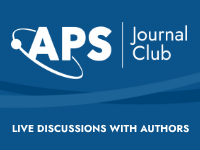| Volume 106, Issue 6 December 2022 | | Advertisement  | PRX Life, APS' newest highly-selective Open Access journal focusing on all aspects of biological organization, has big plans for 2023. Sign up for email alerts to see what the journal is building prior to opening for submissions later this year. Sign up for alerts » | | | | | |
Advertisement | Early bird registration is officially open for March Meeting 2023–one of the largest and most exciting conferences in physics! Witness groundbreaking physics research, network with potential employers, and prepare for career success at March Meeting 2023. Register today » | | | | | | Not an APS member? Join today to start connecting with a community of more than 50,000 physicists. | | | | Featured in Physics Daniel Renjewski, Susanne Lipfert, and Michael Günther Phys. Rev. E 106, 064405 (2022) – Published 8 December 2022  | When humans walk, our feet act as levers rather than landing pads as previously thought. | | | | | | Editors' Suggestion Nicholas Sbalbi, Qi Li, and Eric M. Furst Phys. Rev. E 106, 064609 (2022) – Published 16 December 2022  | Diffusing wave spectroscopy is a light scattering technique that is used to study the dynamics soft materials such as suspensions and gels. In this paper the authors show how interactions between the scattering particles affect the results: the effect is negligible if the scatterers are large enough, but it is significant when the particles are sufficiently small. | | | | | | Editors' Suggestion Jishnu N. Nampoothiri, Michael D'Eon, Kabir Ramola, Bulbul Chakraborty, and Subhro Bhattacharjee Phys. Rev. E 106, 065004 (2022) – Published 26 December 2022  | The classical theory of elasticity has trouble describing disordered jammed solids, such as sandpiles, because they have no unique reference configurations (e.g. a crystal structure). This paper presents a description based on force and torque balance that does not need a reference configuration, and that has a formal similarity with a generalized theory of electromagnetism. | | | | | | Featured in Physics Editors' Suggestion Letter Mahmoud Abdelgalil, Yasser Aboelkassem, and Haithem Taha Phys. Rev. E 106, L062401 (2022) – Published 9 December 2022  | When searching for an egg, sea urchin sperm typically switch between two distinct navigation modes, depending on the relative orientation of their velocity with respect to the chemical gradient of the attractant released from the egg. This paper demonstrates that this navigational strategy can be described by the control algorithm known as extremum seeking. There is no need to define a threshold mechanism to explain the switching behavior, as suggested by previous work. This interdisciplinary work could serve as bridge between scientific communities. | | | | | | | |



No comments:
Post a Comment